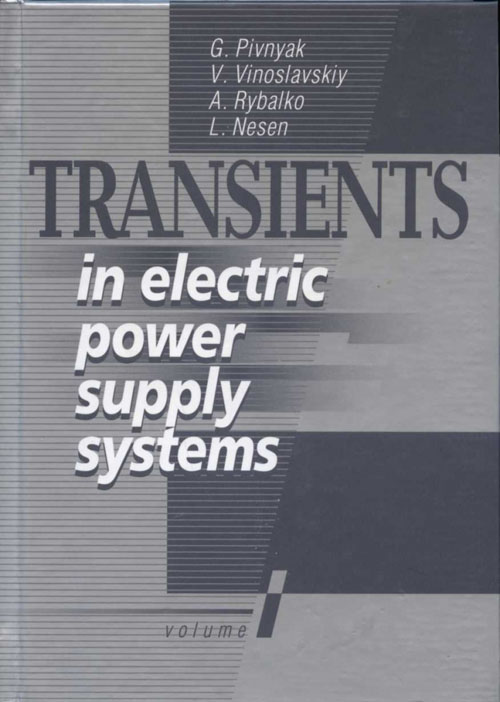| INTRODUCTION |
7 |
CHAPTER 1. |
GENERAL INFORMATION ABOUT TRANSIENTS |
13 |
| |
1.1. Kinds, reasons and consequences of short circuits |
14 |
| |
1.2. Purpose of electromagnetic transients
calculation, design conditions |
17 |
| |
1.3. Basic regularities of snort circuit
currents calculation |
14 |
| |
1.4. Design circuit of electric power supply
system and its components description |
21 |
| |
1.5. Equivalent circuit and methods of
its parameters calculation |
24 |
| |
1.6. Transformations of equivalent circuits |
31 |
| |
1.7. Application of approximate reduction
in per unit |
35 |
| |
Test questions |
37 |
| |
Topics for essay |
37 |
CHAPTER 2. |
TRANSIENTS AT THREE-PHASE SHORT CIRCUITS |
38 |
| |
2.1. Short circuit in radial network without transformer coupling |
39 |
| |
2.2. Short circuit on generator's terminals |
47 |
| |
2.3. Short circuit at remote points of
electric supply network |
51 |
| |
2.4. Initial value of periodic component
of short circuit current |
53 |
| |
2.5. Periodic component of short circuit
current for any instant of time |
56 |
| |
2.6. Short circuit current of emergency
steady state |
58 |
| |
Test questions |
60 |
| |
Topics for essay |
60 |
CHAPTER 3. |
EVALUATION OF TRANSIENTS UNDER THREE-PHASE SHORT CIRCUITS |
61 |
| |
3.1. Basic statements |
62 |
| |
3.2. Use of short circuit periodical component
diagrams in network with one source |
66 |
| |
3.3. Use of short circuit current periodical
component diagrams in a network with several sources |
69 |
| |
3.4. Calculation of short circuit current
periodical component for any time instant by rectified characteristics method |
71 |
| |
3.5. Short circuit currents calculation
on the principle of superposition |
78 |
| |
3.6. Calculation of short circuit current
components stipulated by load centers |
80 |
| |
3.7. Calculation of short circuit currents
in electrical installations with voltage up to 1 kV |
90 |
| |
3.8. Computer-aided calculation of short
circuit current |
106 |
| |
Test questions |
110 |
| |
Topics for essay |
110 |
CHAPTER 4. |
KEY ITEMS CONCERNING ANALYSIS OF TRANSIENTS UNDER ASYMMETRY IN THREE-PHASE
NETWORK |
111 |
| |
4.1. General information |
112 |
| |
4.2. Generation of higher harmonics by
synchronous generator |
112 |
| |
4.3. Method of symmetric components |
115 |
| |
4.4. Relationships between symmetrical
components of current and voltage |
118 |
| |
4.5. Resistances of negative and zero sequences
of circuit elements |
120 |
| |
4.6. Drawing up equivalent circuits for
symmetrical components |
138 |
| |
4.7. Resulting electromotive forces and
impedances of equivalent circuits for separate sequences |
141 |
| |
Test questions |
143 |
| |
Topics for essay |
143 |
CHAPTER 5. |
LATERAL ASYMMETRY |
144 |
| |
5.1. Starting statements |
145 |
| |
5.2. Single-phase short circuit |
147 |
| |
5.3. Two-phase short circuit |
149 |
| |
5.4. Two-phase short circuit to ground
|
152 |
| |
5.5. Account of contact resistance at the
point of short circuit |
154 |
| |
5.6. Equivalence rule for the current of
positive sequence |
156 |
| |
5.7. Integrated equivalent circuits |
159 |
| |
5.8. Comparison of currents at different
short circuits |
162 |
| |
5.9. Symmetrical current and voltage components
transformation |
165 |
| |
5.10. Methods of asymmetrical short circuit
calculation |
172 |
| |
Test questions |
177 |
| |
Topics for essay |
177 |
CHAPTER 6. |
LONGITUDINAL ASYMMETRY AND COMPLEX FAULTS |
178 |
| |
6.1. General statements |
179 |
| |
6.2. Open-phase fault in three-phase network |
180 |
| |
6.3. Two-phases open fault |
182 |
| |
6.4. Connection or unequal resistors in
network phases |
184 |
| |
6.5. Double ground connection |
187 |
| |
6.6. Single-phase short circuit with simultaneous
open-phase fault |
193 |
| |
Test questions |
196 |
| |
Topics for essay |
196 |
CHAPTER 7. |
TRANSIENTS UNDER SPECIFIC CONDITIONS |
197 |
| |
7.1. Short circuits in the network of external electric power supply |
198 |
| |
7.2. Short-circuit to ground in the network
with insulated neutral |
200 |
| |
7.3. Short circuits in the networks of
increased frequency |
205 |
| |
7.4. Transients stipulated by peculiarities
of production process |
205 |
| |
7.5. Processes taking place under capacitor
banks commutation |
208 |
| |
7.6. Short circuits in DC lines |
210 |
| |
Test questions |
215 |
| |
Topics for essay |
215 |
CHAPTER 8. |
LEVELS OF CURRENTS AND POWER OF SHORT CIRCUIT |
216 |
| |
8.1. Quality of electromagnetic transients |
217 |
| |
8.2. Ways of short circuit currents limiting |
219 |
| |
8.3. Use of technical facilities for short
circuit current level optimization |
225 |
| |
8.4. Short circuit current level optimization |
236 |
| |
8.5. Short circuit currents levels coordination |
238 |
| |
Test questions |
240 |
| |
Topics for essay |
240 |
REFERENCE |
241 |
GLOSSARY |
244 |



